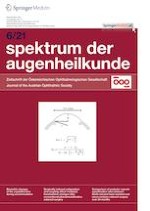15.09.2020 | original article
Biometric changes of the crystalline lens during accommodation
Erschienen in: Spektrum der Augenheilkunde | Ausgabe 6/2021
Einloggen, um Zugang zu erhaltenSummary
Background
To measure intralenticular biometrical changes during accommodation.
Material and methods
This prospective study included two different age groups of volunteers (18–25 years and 30–39 years) and in each age group three different groups of ametropia (emmetropic, myopic, and hyperopic volunteers). All volunteers were measured using partial coherence interferometry (ACMaster, Carl Zeiss Meditec, Germany) in an unaccommodated and an accommodated state. Intralenticular biometric changes concerning anterior and posterior cortex and lens nucleus were analysed.
Results
In total, 104 eyes of 104 volunteers were included in this study. During accommodation in the group of subjects in their 20s, the following changes were observed: In the emmetropic group, the nucleus thickness increased by +0.414 mm, whereas the anterior cortex and posterior cortex thickness remained relatively constant at −0.006 mm (−0.186 mm to 0.046 mm) and +0.008 mm (−0.008 mm to 0.024 mm), respectively.
Conclusions
The increase of the human crystalline lens with age is characterised by a higher increase in cortex thickness than in nucleus thickness. During accommodation, the thickening of the lens is primarily explained by the thickening of the lens nucleus.
Anzeige
